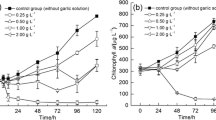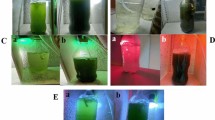Summary
A study was made of the factors affecting the toxicity to the blue-green alga, Anacystis nidulans, of two quinones, 2,3-dichloro-1,4-naphthoquinone and 9,10-phenanthraquinone. These two substances, which are known to be far more toxic to blue-green algae than other quinones so far studied, were shown to differ considerably in their properties. For instance, the toxicity of 2,3-dichloro-1,4-naphthoquinone is increased by light, vitamin K3 and H2O2, whilst vitamin K1 has no effect. On the other hand, the toxicity of 9,10-phenanthraquinone is increased by vitamin K3, decreased by vitamin K1, whilst H2O2 and light have no effect. The toxicity of both substances is decreased by the extracellular materials of various blue-green algae.
Similar content being viewed by others
References
Amesz, J.: Spectrophotometric evidence for the participation of a quinone in photosynthesis of intact blue-green algae. Biochim. biophys. Acta (Amst.) 79, 257–265 (1964).
Black, C. C., jr., and L. Myers: Weeds. (In press, quoted in Cho et al).
Carr, N. G., and M. Hallaway: Reduction of phenolindo-2,6-dichlorophenol in dark and light by the blue-green alga, Anabaena variabilis. J. gen. Microbiol. 39, 335–344 (1965).
Cho, D. H., L. Parks, and G. Zweig: Photoreduction of quinones by isolated spinach chloroplasts. Biochim. biophys. Acta (Amst.) 126, 200–206 (1966).
Fitzgerald, G. P., G. C. Gerloff, and F. Skoog: Studies on chemicals with selective toxicity to blue-green algae. Sewage and Industrial Wastes 24 (7), 888–896 (1952).
—, and F. Skoog: Control of blue-green algae blooms with 2,3-dichloronaphthoquinone. Sewage and Industrial Wastes 26(9), 1136–1140 (1954).
Henninger, M. D., H. N. Bhagavan, and F. L. Crane: Comparative studies on plastoquinones. 1. Evidence for three quinones in the blue-green alga, Anacystis nidulans. Arch. Biochem. 110, 69–74 (1965).
Kratz, W. A., and J. Myers: Nutrition and growth of several blue-green algae. Amer. J. Bot. 42, 282–287 (1955).
Maloney, T. E., and C. M. Palmer: Toxicity of six chemical compounds to thirty cultures of algae. Water and Sewage Works 103, 509–513 (1956).
Marler, J. E., and C. van Baalen: Role if H2O2 in single-cell growth of the blue-green alga, Anacystis nidulans. J. Phycol. 1 (4), 180–185 (1965).
Whitton, B. A.: Extracellular products of blue-green algae. J. gen. Microbiol. 40, 1–11 (1965).
Whitton, B. A.: Studies on the toxicity of polymyxin B to blue-green algae. Canad. J. Microbiol. (in press).
Author information
Authors and Affiliations
Rights and permissions
About this article
Cite this article
Whitton, B.A., MacArthur, K. The action of two toxic quinones on Anacystis nidulans . Archiv. Mikrobiol. 57, 147–154 (1967). https://doi.org/10.1007/BF00408698
Received:
Issue Date:
DOI: https://doi.org/10.1007/BF00408698




